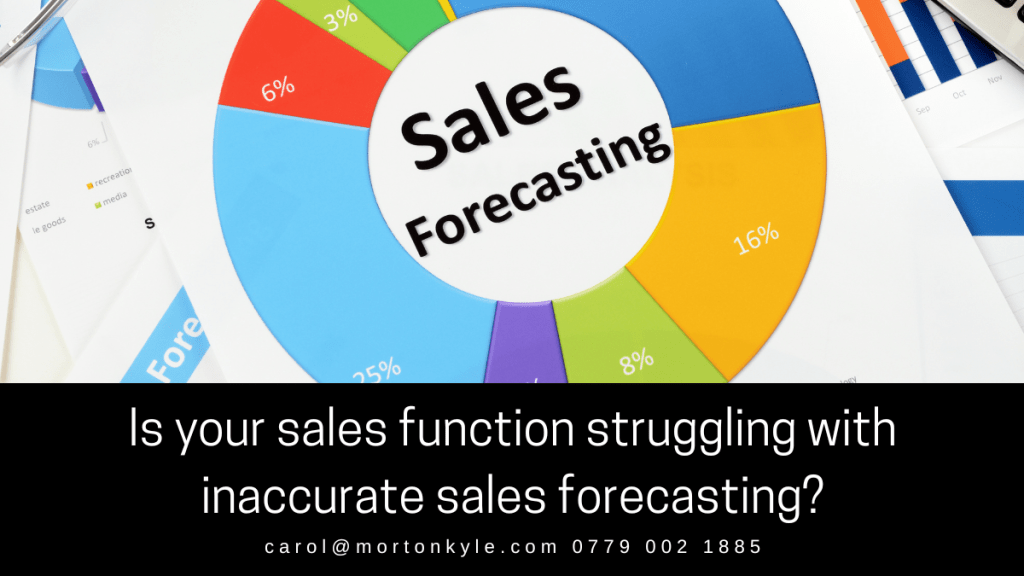How Do We Improve Sales Results?
The question I hear most often…how do we improve sales results? Quickly followed by, where do we start?
Typically, both questions come of the back of many internal conversations and attempts to trade out of less than a less than favourable position, whether it’s a deepening rut or a long term sales plateau.
My first port of call is often to look at the sales forecast.
Sales forecasting is the cornerstone of effective decision-making for growing B2B businesses.
A good sales forecast backed up by a solid sales tracker will tell you exactly what a business can do to improve quickly.
For sales leaders and CEOs, it’s a challenge to get a solid and accurate sales forecast, and this is critical missing link because it means than the business lacks predictability, and it if lacks predictability, it’s a business that can’t scale and is unlikely to grow. Great sales leaders can be derailed without the right insights, data and tools to show them where the gaps are.
Plus, lack of a rock solid sales forecasting methodology shows me you have made no ‘connects’ between cause and effect in the business, and sales performance management is also absent.
Need Help with Building a Sales Forecast and Sales Tracker for Sales Improvement?
If you’re in a business that’s struggling to get either a solid sales forecast or build a sales tracker then can get both built for you as part of the Morton Kyle Sales Audit or the Fix and Flow Sales Sprint
So getting sales forecasting right is a must, it’s not just a routine task; it’s the foundation upon which revenue growth, resource allocation, and strategic planning are built. And will be the cornerstone of any sales improvement efforts.
This blog explores the importance of robust sales forecasting, the pitfalls of inaccurate projections, and how you can refine your forecasting practices to drive sales growth, improve business stability, and boost your bottom line.
What is Sales Forecasting?
Sales forecasting is the process of estimating future sales based on historical data, market trends, and other critical insights. It serves as a roadmap for:
- Revenue Planning: Setting realistic sales targets and aligning them with business goals.
- Resource Allocation: Determining where to focus your sales team’s efforts and how to deploy budgets effectively.
- Operational Efficiency: Ensuring supply chain, production, and staffing align with expected demand.
- Strategic Decision-Making: Informing broader business decisions, from market entry to product development.
- Growth: Where that’s an increase in sales revenue and margin or simply not getting left behind as the market / customers / competitors evolve
In essence, accurate sales forecasting transforms guesswork into actionable insights, helping businesses stay ahead in competitive markets.
Why Timeliness, Accuracy, and Accessibility Matter
As I outlined in the sales tracker blog, sales forecasting isn’t just about crunching numbers. It’s about delivering actionable insights at the right time, with the precision to drive confident decision-making.
Let’s break down the three pillars of effective forecasting:
1. Timeliness
Forecasts that arrive late are as good as useless at the best of times, and totally worthless when it comes to sales improvement. A delayed sales forecast can:
- Render critical decisions outdated.
- Leave your business unprepared for sudden shifts in demand.
- Cause missed opportunities in dynamic markets.
For example, a B2B tech company planning a specific sales campaign needs early sales insights iron out any sales friction early, jump on any glitches in the sales pitch, optimise pricing, focus on responsive (vs non-responsive) sectors, support sales reps. A late forecast disrupts this timeline, jeopardising success from the start. After all, what would you rather have – a three day ramp to success or a three month ramp? Success loves speed!
2. Accuracy
An inaccurate forecast is worse than no forecast at all, and that’s before you see the havoc an inaccurate sales forecast can bring on the relationship with the bank and investors…
Overestimating sales can lead to:
- Overstocked inventory and wasted resources.
- Excessive hiring and inflated operational costs.
- Not paying sufficient attention to feedback from the sales reps / customers / prospects
- Failing to look for efficiencies and productivity hacks with the sales team
- Ludicrous targets
- Unhappy / unmotivated sales reps
Conversely, underestimating sales results in:
- Lost revenue opportunities.
- Paying more for emergency stock
- Unhappy customers due to unmet demand.
Accurate forecasting requires not just historical sales data but also market analysis, competitor insights, and qualitative inputs from your sales team. That’s why a sales forecast without a sales tracker is worthless.
A sales forecast without a well built sales tracker behind it lacks the narrative you need to be able to question the assumptions and conclusions made in the forecast.
3. Accessibility
A sales forecast that’s buried in spreadsheets or siloed within specific teams serves no one. Accessible forecasting tools ensure:
- Real-time collaboration between sales, marketing, finance and operations teams, as well as the board, investors and the bank.
- Clear visibility for CEOs and sales leaders to make data-driven decisions.
- Faster responses to market changes and internal challenges.
The Downside of Getting Sales Forecasting Wrong
Mistakes in sales forecasting ripple across the entire organisation, affecting revenue, operations, and morale, especially when it comes to improving sales and getting a strong grip on sales performance management…again – proving that a sales forecast needs a strong sales tracker attached to it to give it robustness and validity.
Here’s what’s at stake:
1. Revenue Loss
Forecasting errors can lead to incorrect pricing strategies, poorly timed promotions, or missed opportunities in high-demand markets.
2. Wasted Resources
An overoptimistic sales forecast can inflate costs unnecessarily. Overstaffing, excess inventory, or overly aggressive marketing campaigns strain cash flow, creating financial instability.
3. Damaged Reputation
In B2B markets, reliability is everything. Failing to meet delivery deadlines due to poor demand planning can erode customer trust and damage long-term relationships.
4. Team Frustration
Sales teams are often demoralised by unrealistic targets or a lack of clarity about their performance metrics. Poor forecasting creates a disconnect between leadership and frontline teams, impacting productivity and morale.
5. Strategic Drift
Inaccurate forecasts lead to misguided strategies, whether it’s entering new markets prematurely, launching unviable products, or misjudging competition. Over time, this erodes your competitive edge.
Optimising Your Sales Forecasting Process
Improving your sales forecasting isn’t just about adopting new tools; it’s about instilling discipline, leveraging data, and fostering collaboration across teams. Here’s how to get started:
1. Leverage Advanced Technology
Modern CRM systems and forecasting tools, powered by AI and machine learning, offer predictive analytics that goes beyond historical data. These tools:
- Identify patterns and trends with greater accuracy.
- Integrate seamlessly with your existing systems.
- Provide real-time insights for agile decision-making.
2. Adopt a Data-Driven Approach
Relying solely on gut instinct or anecdotal evidence is a recipe for failure. Instead:
- Use historical sales data to identify trends.
- Start to track a range of the micro sales metrics that showcase cause and effect in the sales function – the more granular the metrics the easier sales improvement will be – if you need help to set this up call 0779 002 1885 to book a call
- Incorporate market research to understand external influences.
- Combine quantitative data with qualitative insights from your sales team.
3. Foster Cross-Departmental Collaboration
Sales forecasting isn’t just the responsibility of the sales team. By involving marketing, operations, and finance:
- You gain a holistic view of factors influencing sales.
- You ensure alignment across departments.
- You create a shared commitment to achieving targets – building a picture of the flow of money across a business helps hugely with this
4. Regularly Review and Adjust
Sales forecasting is not a “set it and forget it” process. Regular reviews help you. The more micro the sales metric and the more frequent the review, especially at the very early stages of any sales improvement effort the faster you’ll get the sales results you need. it will also help you to:
- Adapt to changing market conditions.
- Incorporate feedback from frontline teams.
- Refine forecasting models to improve accuracy over time.
5. Train Your Team
Ensure your sales team understands the importance of accurate data entry and reporting. Provide training on:
- Using CRM tools effectively.
- Recognising and mitigating biases in forecasting.
- Communicating insights to leadership clearly.
How Morton Kyle Can Help You
At Morton Kyle, we specialise in helping B2B businesses unlock the full potential of their sales processes, including sales forecasting. Here’s what we offer:
- Sales Audits: We analyse your current forecasting practices to identify gaps and inefficiencies.
- Customised Training: Equip your team with the skills and tools needed for accurate and timely forecasting.
- Coaching for Leaders: Empower CEOs and sales leaders to make data-driven decisions with confidence.
- Ongoing Support: From implementing advanced forecasting tools to refining your processes, we’re with you every step of the way.
Take Control of Your Sales Forecasting Today
When it comes to sales improvement, there’s no room for guesswork. Accurate, timely, and accessible sales forecasts with a relevant and easy to use sales tracker are essential for driving growth, maintaining stability, and staying ahead of the competition.
Sales improvement isn’t a nice to have any more…it’s simply the cost of being in business. If competitive strength is on your agenda this year then I can help you ensure your sales processes, sales forecasting and sales tracker are fit for purpose.
So, if you are you ready to transform your sales forecasting process? Book a call with Carol today – 0779 002 1885. Let’s discuss how we can help you achieve predictable sales growth, unlock hidden opportunities, and build a more resilient business.
Call Now – 0779 002 1885 and take the first step toward mastering sales forecasting.
With the right approach to sales forecasting, an accurate sales forecasting methodology and a narrative rich sales tracker, you’re not just predicting the future—you’re creating it. Let Morton Kyle help you make it a future of success, stability, and growth.

Who am I?
I’m Carol Griffiths, and I’ve spent the last 30+ years in the trenches of sales—fixing broken pipelines, rebuilding underperforming teams, and helping businesses close more deals at higher margins.
I’ve worked with global brands, challenger firms, and fast-growth sales teams, helping them:
✔ Fix underperforming pipelines – turning ghosted leads into closed deals.
✔ Increase win rates – without discounting or chasing bad-fit prospects.
✔ Build sales systems that actually work – so you don’t waste time on ‘busy work’ that doesn’t convert.
I’m not another ‘sales trainer.’ I don’t teach theory. I fix sales problems – fast. And if you’re still reading, it means you’ve got a problem that needs fixing.
I know how sales leaders think because I’ve been one. I know what the board wants because I’ve sat in those meetings.
And I know what works – because I’ve done it, tested it, and proved it across industries, markets, and economic downturns.




